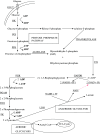Cancer's craving for sugar: an opportunity for clinical exploitation
- PMID: 19415328
- PMCID: PMC12160197
- DOI: 10.1007/s00432-009-0590-8
Cancer's craving for sugar: an opportunity for clinical exploitation
Abstract
More than 80 years ago, Otto Warburg described the phenomenon whereby cancer cells avidly take up glucose and produce lactic acid under aerobic conditions, a process subsequently referred to as the Warburg effect or aerobic glycolysis. The exact molecular mechanisms underlying cancers reliance on glycolysis remains unclear, but is likely a combination of an epigenetic response to the hypoxic tumour environment in combination with direct oncogenic stimulation. The aim of the current manuscript is to review the normal process of glycolysis and highlight the alterations that occur with malignant transformation, to consider the potential advantages of glycolytic respiration for cancer cell survival, and finally to explore areas where altered glucose metabolism can be exploited for clinical benefit.
Figures



References
-
- Altenberg B, Greulich KO (2004) Genes of glycolysis are ubiquitously overexpressed in 24 cancer classes. Genomics 84(6):1014–1020. doi:10.1016/j.ygeno.2004.08.010 - PubMed
-
- Arora KK, Pedersen PL (1988) Functional significance of mitochondrial bound hexokinase in tumor cell metabolism. Evidence for preferential phosphorylation of glucose by intramitochondrially generated ATP. J Biol Chem 263(33):17422–17428 - PubMed
-
- Asaka M, Kimura T, Meguro T, Kato M, Kudo M, Miyazaki T et al (1994) Alteration of aldolase isozymes in serum and tissues of patients with cancer and other diseases. J Clin Lab Anal 8(3):144–148. doi:10.1002/jcla.1860080306 - PubMed
-
- Atsumi T, Chesney J, Metz C, Leng L, Donnelly S, Makita Z et al (2002) High expression of inducible 6-phosphofructo-2-kinase/fructose-2, 6-bisphosphatase (iPFK-2; PFKFB3) in human cancers. Cancer Res 62(20):5881–5887 - PubMed
-
- Baggetto LG (1992) Deviant energetic metabolism of glycolytic cancer cells. Biochimie 74(11):959–974. doi:10.1016/0300-9084(92)90016-8 - PubMed
Publication types
MeSH terms
Substances
LinkOut - more resources
Full Text Sources
Other Literature Sources

